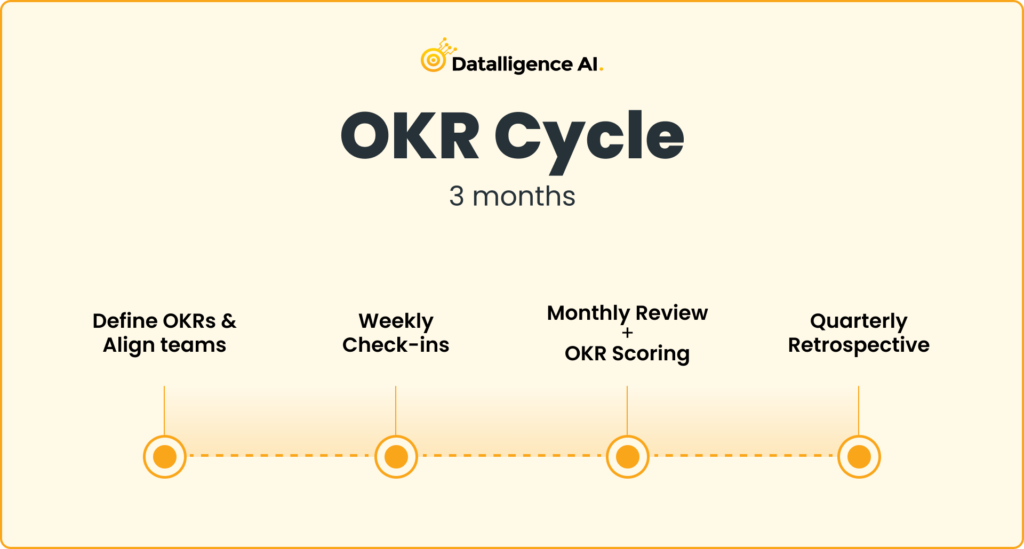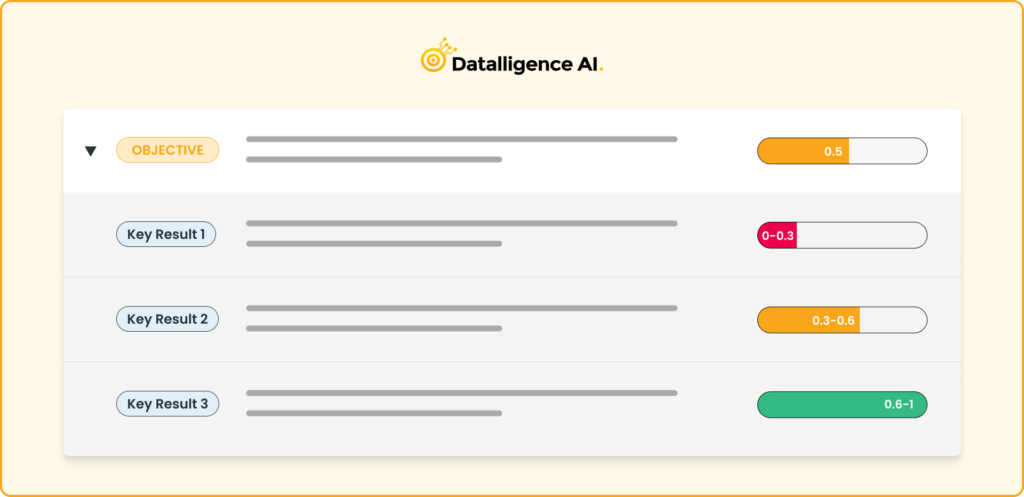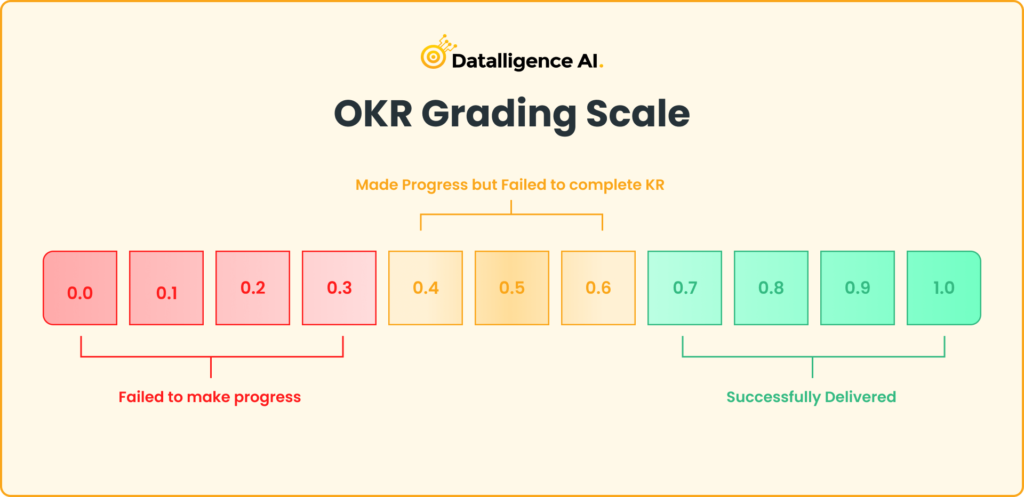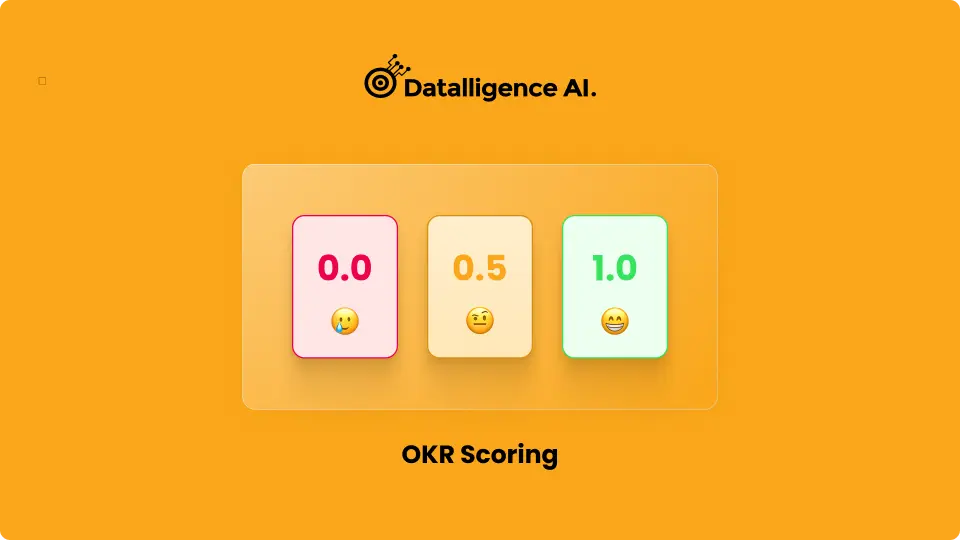“What gets measured gets managed.” – Peter Drucker
This famous quote by management consultant Peter Drucker encapsulates the importance of setting measurable goals and objectives in any organization or personal venture. In today’s fast-paced business world, OKR Tracking Tool has emerged as a powerful framework to set, measure, and achieve those goals. But how do you measure the success of your OKRs?
In this blog, we will explore the ins and outs of OKR Scoring, how to score OKRs, and how to effectively track progress toward your objectives.
What is OKR Tracking?
OKR tracking is the process of measuring progress toward objectives and key results, helping businesses evaluate their performance effectively. It provides a quantitative assessment that offers insights into goal achievement, enabling teams and individuals to reflect, adjust, and strategize for future success.
At its core, OKR tracking helps answer two key questions:
- How well are we progressing toward our objective?
- Did we accomplish the key results we set out to achieve?
What is OKR Scoring
OKR Scoring is the process by which businesses evaluate the extent to which they’ve achieved their OKRs. It provides a quantitative measure that gives insights into the progress made toward objectives, making it easier for teams and individuals to reflect, adjust, and strategize for future performance.
In its essence, OKR Scoring helps answer two primary questions:
- How well are we progressing towards our objective?
- Did we achieve the key results we set out to accomplish?
When to Score OKRs

Three times during a quarterly OKR cycle is the ideal number of times to grade OKRs. whenever the team conducts its monthly reviews.
Since they plan annually, businesses like LinkedIn and Google might evaluate OKRs less frequently. They might not use OKR scoring in their quarterly retrospectives, in other words.
However, scoring OKRs during your monthly OKR review works best within the OKR cycle for smaller businesses and those who are new to the OKR methodology. Teams can use this time to become accustomed to the procedure, identify what’s working and what isn’t, and make adjustments earlier in the OKR cycle.
How Do You Score OKRs
Scoring OKRs is essential to gauge the progress and understand how closely objectives are being met. The score provides a numerical representation of the performance.
Here’s how you can score OKRs
1. The 0-1.0 Scale
The most common way to score OKRs is on a scale of 0 to 1.0, with 0 indicating no progress and 1.0 signifying that the key result is fully achieved. Anything above 0.7 is typically considered good progress. Alternatively, one can simplify the scale even further by only using colors and emojis.
- 0.7 to 1.0: Green = We delivered.
- 0.4 to 0.6: Yellow = We have made progress, but fell short of completion.
- 0.0 to 0.3: Red = We failed to make any real progress.

Example:
Objective: Increase user engagement on our platform.
Key Result: Achieve a 20% increase in monthly active users.
If by the end of the cycle, you’ve achieved a 14% increase, then: Score = 14/20 = 0.7
2. Percentage Completion
This involves assessing the percentage of completion of the key result.
Example:
Objective: Improve our content strategy.
Key Result: Publish 50 new articles in the quarter.
If 35 articles are published by the end of the cycle: Score = (35/50) x 100 = 70% completion.
3. Binary Scoring
This is a straightforward yes/no or 0/1 system, where the KR is either fully achieved (1) or not achieved (0).
Example:
Objective: Launch the new software version.
Key Result: Release version 2.0 by the end of Q2.
If the version is released by the target date, the score is 1. If not, the score is 0.
4. Graduated Scale
Instead of an all-or-nothing approach, the graduated scale provides some leeway. You’d determine bands of success.
Example:
Objective: Grow our social media presence.
Key Result: Gain 10,000 new Twitter followers.
If followers increase by 10,000 or more, the score = 1.0
Increase by 7,000 – 9,999, score = 0.7
Increase by 4,000 – 6,999, score = 0.4
Increase by 0 – 3,999, score = 0.1
5. Conditional Scoring
Scoring is based on conditions being met.
Example:
Objective: Improve customer support.
Key Result: Reduce ticket response time to under 2 hours and maintain a satisfaction rate of 90%.
If both conditions are met, score = 1.0
If only one condition is met, score = 0.5
If neither condition is met, score = 0
When scoring OKRs, it’s vital to be transparent and honest. The objective isn’t just to achieve high scores, but to genuinely understand progress and areas of improvement. Over time, this reflective process will lead to better alignment and more achievable OKRs.
Google OKR Grading Scale
Google, being one of the pioneers of the OKR methodology, has its own approach when it comes to scoring OKRs. Their method has been widely recognized and imitated by various organizations worldwide.
Here’s an outline of Google’s OKR scoring system:
Google’s OKR Scoring System:
1. 0-1.0 Scale
Google scores its OKRs on a scale of 0 to 1.0.
- 0 means no progress has been made.
- 1.0 means the key result is fully achieved.

Understanding OKR Scores
The 0 to 1.0 scale is widely used to measure key result progress. However, achieving a perfect 1.0 doesn’t always indicate success—it could mean the goal was too easy and lacked ambition.
A score of 1.0 means the key result was fully achieved, but consistently scoring this high may suggest the objectives were not challenging enough. Scores between 0.7 and 0.9 indicate strong progress, showing that the objective was ambitious yet achievable. A score between 0.6 and 0.7 is considered good, meaning significant progress was made toward a challenging goal. Anything below 0.4 signals a need for further analysis, as the objective was not met, and there may have been obstacles or unrealistic expectations.
Using an OKR tracking tool, organizations can monitor progress more efficiently, identify areas for improvement, and align teams towards achieving their goals.
Ambition Over Achievement in OKR Scoring
A key principle in OKR methodology, followed by companies like Google, is to set ambitious, stretch goals rather than just meeting safe, easily achievable targets. The philosophy is that aiming high and falling slightly short is still a success.
If a team consistently scores 1.0, it may indicate that their OKRs were too conservative. Ideally, teams should aim for a 0.7 to 0.9 range, meaning they pursued a bold goal and made significant progress without making it too easy.
An OKR tracking tool helps maintain this balance by allowing teams to track progress dynamically, ensuring that goals remain challenging yet realistic.
Example of OKR Scoring Using Google’s Approach
Consider an objective to develop a faster search algorithm. If the key result is to reduce search response time by 20%, the final score depends on actual progress.
If the response time is reduced by 10%, the score would be 0.5, reflecting moderate progress. If no reduction happens, the score would be 0, indicating no progress. If the response time is reduced by 20% or more, the score would be 1.0, but this raises a question—was the goal ambitious enough?
This is why OKR scoring is about more than just numbers; it’s about ensuring goals push boundaries while still being achievable.
How an OKR Tracking Tool Enhances Scoring
An OKR tracking tool makes scoring easier and more insightful by automating progress tracking, visualizing performance, and aligning teams. It eliminates manual calculations, providing real-time updates on whether key results are on track or need adjustments.
With features like progress tracking, data visualization, and performance insights, an OKR tracking tool helps teams focus on the bigger picture—achieving ambitious goals while learning from the process.
Benefits Of OKR Scoring
Scoring OKRs isn’t just about assigning a numerical value to performance. When done correctly, it provides a myriad of benefits that can transform the trajectory of an organization.
Here’s a detailed look into the benefits of OKR scoring:
1. Immediate Visibility: OKR scoring provides a snapshot of progress, enabling everyone to see how they align with organizational goals.
2. Promotes Accountability: Knowing efforts will be quantitatively evaluated makes teams and individuals more responsible and committed to their roles.
3. Constructive Feedback: Regular scoring opens channels for feedback, helping identify areas of growth and improvement.
4. Drives Alignment & Focus: Teams remain in tune with the organization’s objectives, ensuring unified direction and purpose.
5. Encourages Ambition: Emphasizes setting and aiming for challenging goals, leading to greater achievements.
6. Guides Resource Allocation: Helps in identifying areas that need more attention, enabling better resource distribution.
7. Data-Driven Decision Making: Insights from scoring guide strategic decisions and help understand effective strategies.
8. Motivation & Engagement: Meeting or surpassing OKR scores boosts morale and team cohesion.
9. Promotes Continuous Improvement: Regular scoring instills a culture of reflection and iterative progress.
10. Enhances Transparency: Scoring and sharing OKRs openly creates a clear and unified working environment, ensuring everyone knows where they stand.
OKR Grading Scorecard Template
Creating an OKR grading scorecard can help streamline the process of assessing performance and progress toward goals.
Here’s a simple OKR Grading Scorecard Template that organizations can use:
OKR Grading Scorecard
Department/Team: [Department Name]
OKR Cycle: [e.g., Q1 2023]
Review Date: [Date of review]
Objective 1: [Insert Objective Here]

Average Score for Objective 1: [Calculate average of KR scores]
Objective 2: [Insert Objective Here]

Average Score for Objective 2: [Calculate average of KR scores]
Overall Average Score for the Cycle: [Calculate overall average across all KRs]
General Comments/Feedback:
- [Any overarching feedback or observations]
- [Insights into overall team performance or external factors impacting results]
- [Recommendations or action items for the next cycle]
Organizations can modify and expand this template based on their specific needs, the complexity of their OKRs, or any additional data they want to capture. This scorecard serves as a standardized tool for evaluating progress, discussing results, and planning future strategies.
Tips For Scoring OKRs
Scoring OKRs effectively is paramount to ensuring that the system drives both performance and growth within an organization.
Here are some key tips to help you score OKRs more effectively:
- Use a consistent 0-1.0 scoring scale for clarity.
- Maintain transparency in the scoring process.
- High continuous scores hint at less challenging goals.
- Actively engage teams during the scoring phase.
- Treat low scores as growth insights, not failures.
- Separate OKR scores from personal performance reviews.
- Regularly review and adjust targets as needed.
- Document scores for future retrospectives and planning.
- Use scores as a basis for strategic discussions.
- Foster an environment where scores facilitate, not dictate, decisions.
How Do You Score OKRs?
Scoring OKRs is a crucial step in assessing progress and determining how effectively objectives are being met. A well-defined scoring system provides a clear, numerical representation of performance, allowing teams to evaluate their success and identify areas for improvement.
OKR Scoring Methods
1. The 0-1.0 Scale
The most widely used OKR scoring method follows a scale from 0 to 1.0, where:
- 0.7 to 1.0 (Green) – The key result is largely or fully achieved. This range indicates strong performance and successful execution of the objective.
- 0.4 to 0.6 (Yellow) – Some progress was made, but the goal was not fully met. This suggests areas that need further attention or improvement.
- 0.0 to 0.3 (Red) – Minimal or no progress was made toward achieving the key result. This signals a need for reassessment and strategy adjustment.
Some organizations also simplify tracking by using color codes or emojis instead of numerical scores for quick visual representation.
2. The 0-2.0 Scale
For a more detailed assessment, OKR tracking can also be done using a 0 to 2.0 scale, where:
- 1.0 – The expected target was fully met.
- 1.5 – The team exceeded expectations and achieved beyond the set key result.
- 2.0 – The outcome significantly surpassed expectations, demonstrating outstanding success.
- Below 1.0 – The key result was only partially achieved, requiring further analysis to improve performance.
How the 0-100 OKR Scoring System Works
The 0 to 100 scale allows organizations to assign a percentage-based score to each key result, making it easier to interpret performance levels. Here’s how it works:
0-30 (Red) → Limited or No Progress
- The key result is either untouched or significantly underachieved.
- Requires immediate attention and potential strategy adjustments.
31-69 (Yellow) → Partial Progress
- Some work has been done, but the goal remains incomplete.
- Indicates a need for further effort or potential obstacles.
70-100 (Green) → Achieved or Exceeded
- The key result is successfully completed or surpassed.
- Scores closer to 100 indicate outstanding performance.
Why Use a 0-100 Scale for OKR Tracking?
- More Precision → Unlike a simple 0-1.0 scale, this method offers detailed tracking by showing incremental progress.
- Better Alignment with Performance Metrics → Many businesses use percentage-based KPIs, making integration easier.
- Granular Insights → Helps teams analyze which areas need improvement and where they are excelling.
Conclusion:
Scoring OKRs is not just about measuring success; it’s about driving continuous improvement and setting ambitious yet achievable goals. With an OKR tracking tool, businesses can effectively monitor progress, adjust strategies, and ensure that teams stay aligned and motivated.
By focusing on ambition over perfection and using real-time insights, organizations can drive innovation, improve execution, and achieve high-impact results. 🚀











